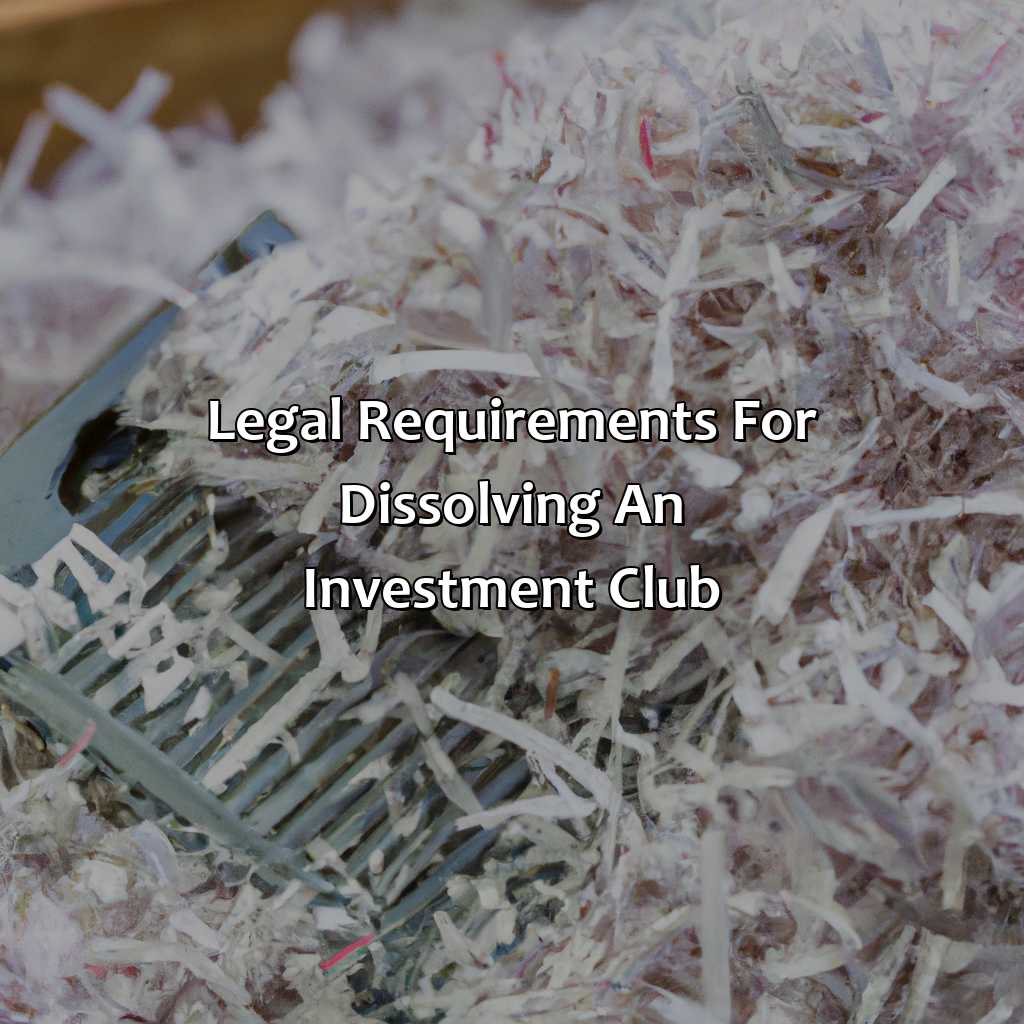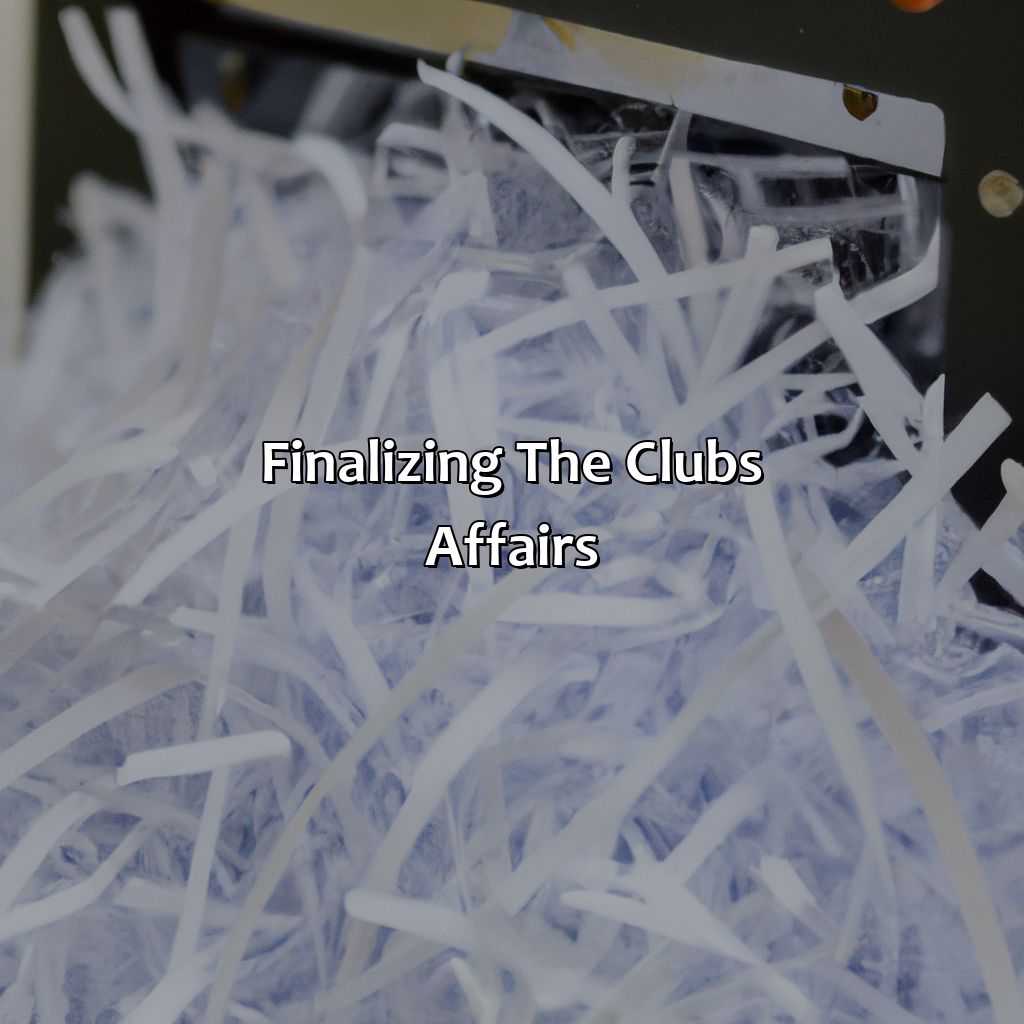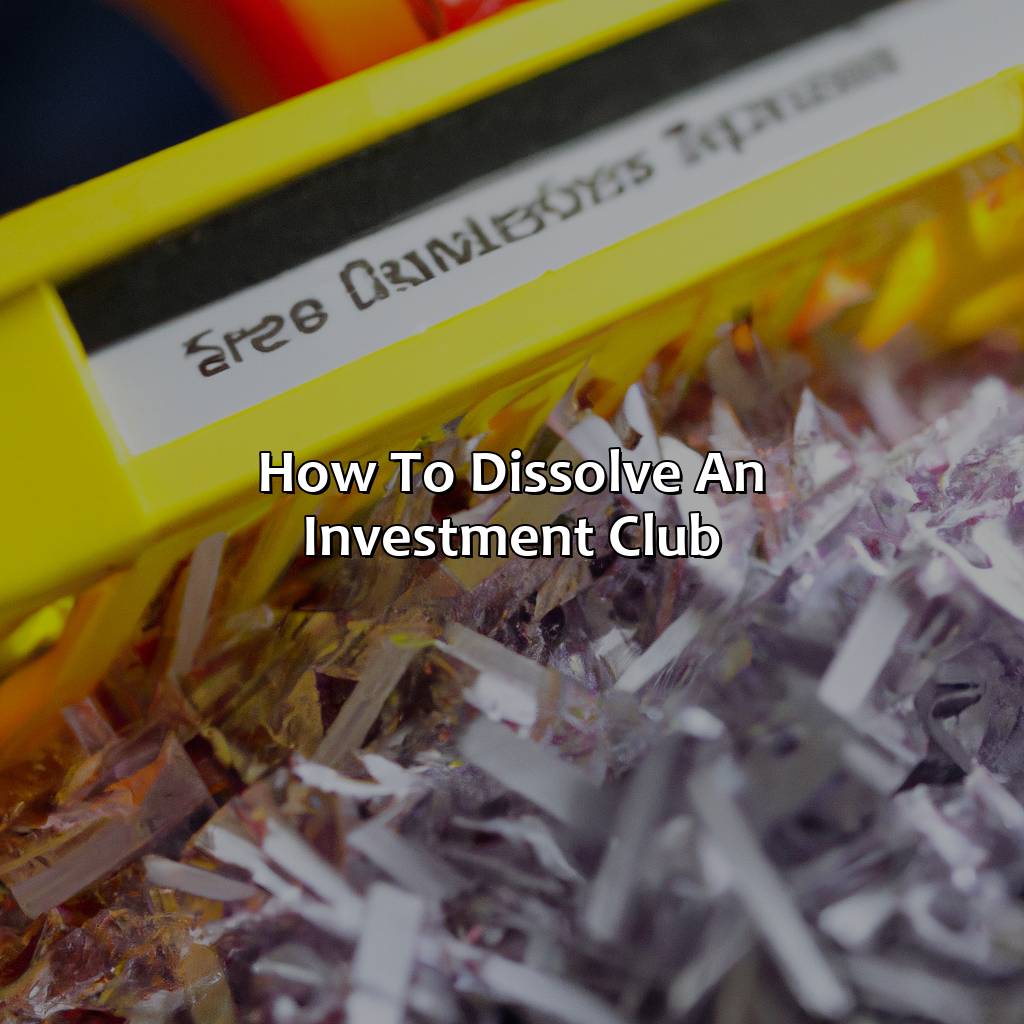How To Dissolve An Investment Club?
Key Takeaway:
- An investment club can be dissolved due to lack of interest, financial losses, or disagreements among members. It is important to identify the primary reason for dissolution to ensure a smooth process.
- Legal requirements for dissolving an investment club include filing articles of dissolution, notifying members and creditors, and distributing club assets among members. It is important to follow these legal procedures to avoid any legal complications.
- The process of distributing club assets among members includes selling holdings, distributing cash and property, and settling any outstanding club debts. It is essential to prioritize communication and transparency among members throughout the entire process
Are you part of an investment club that needs to be dissolved? Dissolving an investment club can be a difficult process, but with the right steps you can make it simpler. In this article, we’ll discuss how to dissolve an investment club quickly and easily.
Reasons for Dissolving an Investment Club
Analyze why your investment club dissolved. No enthusiasm, financial losses, and arguments between members can all be reasons why. To solve the difficulties, it is important to look more into each part and find the original source of the trouble.

Image credits: retiregenz.com by Yuval Woodhock
Lack of Interest
Investment clubs may face the challenge of dwindling participation and engagement, resulting in a reduction or total lack of interest from members. This challenge is one of the most common reasons for dissolving investment clubs.
It is imperative to establish whether the lack of interest is temporary or long-term before contemplating dissolution. The interested parties should engage in discussions to understand what causes the disinterest, ranging from suboptimal returns to differences in investment philosophies.
Peer pressure and social proof can be powerful drivers of group behavior. When some members leave an investment club, others may follow suit, leading to its eventual dissolution despite possible revival opportunities.
Consideration for potential remedies like rebranding, changing investing strategies or reaching out to new members could help revive interest and continue growing the investment club’s value proposition. However, if members’ interests have been exhausted without prospects for revival, it might be best to end on a high note.
In summary, an investment club facing a lack of interest can weigh in on membership feedback and strategize on potential revival options. If there seems to be no remedy towards improved participation levels despite meaningful attempts, then dissolve the club altogether- better late than never.
Looks like the only investment these club members made was in their ability to lose money.
Financial Losses
Unresolved losses can lead to the dissolution of an investment club as they can damage investor confidence and negatively impact the club’s profitability. High-risk investments that don’t perform as expected can cause significant financial losses. Such a situation may arise due to insufficient research, external factors like market volatility, or poor decision-making by members. These unresolved losses could create fear among investors and result in the windup of the investment club.
It is crucial to ensure that all losses incurred by an investment club are monitored and managed efficiently to avoid further losses. One potential solution is to diversify the portfolio by spreading investments across different securities or sectors. This strategy can minimize risks that come from investing heavily in one asset type, class, or industry. The importance of proper record-keeping and managing finances cannot be understated, particularly when operating an investment vehicle with multiple participants.
To prevent a similar fate for your investment club, it would be wise to adhere to a strict set of rules governing the selection of investments, trading policies, and risk management protocols while maintaining transparency in financial reporting. Keeping members up-to-date with regular progress updates and annual audits can instill greater confidence in your clubs’ performance.
If left unchecked financial losses, whether realized or unrealized may lead to more significant losses over time. It is always better to take action early on rather than wait for things to spiral out of control. If you’re dealing with unresolved losses in your investment club or want to safeguard against their occurrence in the future, it would be wise to seek professional expertise from a financial advisor or other industry experts who have more experience managing risks associated with investment vehicles.
Investment clubs provide a unique opportunity for individuals to pool resources together and invest in securities collectively. But it also comes with its own set of risks and challenges that require careful consideration before taking any steps towards formation. By adopting a proactive approach towards risk management and adhering strictly to rules governing operations within the group, investment clubs can achieve better outcomes and reduce the likelihood of dissolution due to financial losses.
When it comes to investment clubs, disagreements among members are a surefire way to make everyone a little poorer and a lot more angry.
Disagreements among Members
Disputes amidst Investment Club Members
Members of investment clubs may at times disagree and reaching a mutual agreement might be impossible. Here are the reasons for disputes:
- Differences in Investment Strategies and styles
- Mismanagement of finances
- Interpersonal conflicts between members
- Conflicts arising from voting rights distribution
- Disparities in division of profits or losses among partners
It is important to note that disagreements are one of the normal challenges faced by an investment club. Nevertheless, when they escalate and no consensus is reached, dissolving the club becomes inevitable.
Pro Tip: Consider creating a dispute resolution mechanism for members to deal with any issues amicably. Getting out of an investment club is like breaking up with a clingy partner – it’s best to follow all the legal requirements to avoid any messy consequences.
Legal Requirements for Dissolving an Investment Club
To dissolve an investment club, legal rules require Articles of Dissolution to be filed. This is very important, to prevent any legal hassles. Here, we will look at the steps required to properly dissolve an investment club. We will look at the two sub-sections in detail:
- Filing Articles of Dissolution
- Notifying Members and Creditors

Image credits: retiregenz.com by James Jones
Filing Articles of Dissolution
When dissolving an investment club, you need to file legal documents with the state. The process of filing such legal documentation is referred to as submitting dissolution articles.
Here’s a 6-step guide on how you can file your club’s dissolution articles:
- Obtain the necessary forms – Depending on your state, you may need to obtain specific forms when filing dissolution articles for an investment club.
- Fill out the forms – Fill out all the information needed regarding your investment club and its members.
- Draft a resolution document – This document must be signed by all members of the investment club and indicate that everyone is in agreement with dissolving it.
- File the documents – After completing all forms and obtaining signatures, submit them to the state agency responsible for business filings.
- Publish documentation – Once approved by the state agency, publish notice of your club’s dissolution in local newspapers or other media outlets.
- Close accounts and distribute assets – Finally, dissolve any existing bank accounts or other financial holdings, distribute remaining assets appropriately among members mentioned in documentation.
Please note that before taking any step with regard to an investment club’s dissolution process, it is always advisable that you consult a lawyer familiar with this area.
One common issue faced during this process is resolving any outstanding liabilities. To avoid complications after dissolution, ensure that all debts are cleared and no unpaid bills exist.
To streamline this process and reduce delays or rejections from state agencies consider seeking professional services like getting a registered agent or having lawyers draft customized resolutions that suit the requirements set up by State regulators. Hiring professionals can avoid common mistakes made when navigating such territory alone to have faster completion timeframes while still ensuring accuracy under complicated investing regulations.
Time to break the bad news to your investment club members and creditors: we’re dissolving faster than a sugar cube in hot tea.
Notifying Members and Creditors
The process of informing both members and creditors about dissolving an investment club is crucial. A written notice that outlines the dissolution must be sent to all members, including the reason and date for such action. As for creditors, they should also be notified through a written document outlining the club’s financial position along with its plans to settle any outstanding debts.
It is vital to ensure that both parties are aware of the situation to prevent any legal disputes or complications that may arise later on. Once notified, members are given ample time to withdraw their shares, and creditors can make payment claims if necessary.
Additionally, it is essential to maintain communication with both members and creditors throughout the dissolution process in case of further inquiries. Open communication channels help minimize misunderstandings and facilitate smooth transactions.
According to Investopedia, “Failure to provide proper notification exposes the investment club’s treasurer or other responsible parties to personal liability.” Therefore it is crucial, as responsible parties, that notifying members and creditors is done correctly.
Dividing the pie has never been more complicated- unless you’re splitting up a cake, then it’s just delicious.
Distributing Club Assets among Members
Dissolving an investment club? To do that, you need to understand the legal and financial duties. This section can help! It’ll guide you through the process of distributing club assets like selling holdings, giving out cash and property. And make sure each member gets their fair share.

Image credits: retiregenz.com by Joel Duncun
Selling Holdings
When it comes to Distributing Club Assets among Members, divesting Holdings is a crucial step. Here are six points to consider while selling investments:
- Assess the current market value of the holdings.
- Choose a broker that suits your requirements.
- Decide on the method of sale: limit or market order?
- Inform all the members about the selling before proceeding.
- Sell and settle any tax obligations at fair rates.
- Distribute the proceeds equitably following club agreement.
It’s essential to note that carrying out due diligence before Selling Holdings guarantees that risk mitigation is in place. Additional attention should be given to any legal requirements needed by relevant authorities.
There was an Investment Club that decided to dissolve after two years, keeping this specification a secret for some time until they had sold their Holdings. Nevertheless, one member discovered their decision and chose to sell his shares before there was no option left.
Time to break out the Monopoly board and let the real estate wheeling and dealing begin.
Distributing Cash and Property
Managing distribution of club assets among members is crucial in dissolving an investment club. Utilizing a structured approach can assist in a smooth transition process and help avoid potential conflicts.
- Establish a fair distribution methodology that accommodates both cash and property assets
- Conduct a valuation of the existing assets to determine their worth
- Ensure all outstanding debts, taxes, and fees are paid from the club’s assets before any distribution is made
- Allocate percentages of the funds based on individual capital contributions to the club
- Distribute any remaining funds and assets amongst all members according to an established agreement or rules laid out within the operating documents of the club
- Create final documentation recording asset disbursement and maintain accurate communication with involved parties
It is essential to address unique circumstances such as partial ownership, tax implications, or retirement accounts when distributing assets among members. Addressing these issues promptly can prevent financial or legal issues down the line.
Pro Tip: Ensure each member reviews all documentation regarding asset distributions to eliminate confusion or disputes later on.
Time to break out the calculator and start dividing up those debts like they’re a limited edition set of Pokemon cards.
Settling any Outstanding Club Debts
Settling Financial Obligations in Dissolving an Investment Club
It is crucial to resolve all outstanding club debts before dissolving an investment club. This ensures that all members are paid their fair share of the club’s profits, and the club is dissolved according to the agreement.
To settle any outstanding club debts, the investment club must first conduct an audit to determine the financial position of the club. The audit should take into account all club expenses, including taxes, fees, and any outstanding loans or debts. Once the audit is complete, the club should inform all members of the total outstanding club debts.
The club should then prioritize paying off the outstanding debts to creditors and any outstanding loans from members. It is essential to communicate with creditors and members regarding the payment schedule and negotiate any payment arrangements if necessary. Once all financial obligations are settled, the investment club can distribute any remaining proceeds to members based on their proportional ownership.
In addition to settling club debts, it may be practical to consult a legal professional or financial advisor to ensure that the dissolution process is handled correctly. They can provide guidance on legal and tax implications, as well as recommend the appropriate steps to take. It is also essential to keep accurate records of all financial transactions and correspondence regarding the dissolution to avoid any legal disputes in the future.

Image credits: retiregenz.com by Adam Jones
Finalizing the Club’s Affairs
After deciding to dissolve an investment club, it is important to take necessary steps to finalize the club’s affairs. This includes dealing with club assets, liabilities, and member investments. All members should be informed of the dissolution and a plan should be put in place to distribute any remaining funds or assets. It is advisable to seek professional assistance in navigating potential legal and tax implications.
When finalizing the club’s affairs, it is important to consider the financial well-being of all members. Legal documentation such as a dissolution agreement can be drafted to outline the process and protect members from potential disputes. Selling the club’s assets, paying off any outstanding debts, and distributing remaining funds in a fair and transparent manner are important steps in successfully concluding the club.
It is important to note that each investment club may have unique circumstances to consider during the dissolution process. Seeking professional advice can help navigate potential legal and financial obstacles, and ensure a smooth transition for all involved.
A friend of mine recently dissolved their investment club and encountered some unexpected tax implications. It highlighted the importance of seeking professional advice and thoroughly researching any potential legal and financial consequences before finalizing the club’s affairs.

Image credits: retiregenz.com by Joel Jones
Some Facts About How To Dissolve An Investment Club:
- ✅ To dissolve an investment club, a majority vote by members is usually required. (Source: Investor.gov)
- ✅ The club’s assets may be distributed among members based on their contributions and participation. (Source: The Balance)
- ✅ Club bylaws should outline the procedures for dissolution. (Source: Dummies.com)
- ✅ Members should agree on the club’s final tax returns and financial statements before dissolving. (Source: Money Crashers)
- ✅ Dissolving an investment club can be complicated and stressful, but it may be necessary if there are conflicts or a lack of participation. (Source: The Motley Fool)
FAQs about How To Dissolve An Investment Club?
What is an investment club and why would someone want to dissolve it?
An investment club is a group of individuals who pool their money together to invest in stocks, bonds, and other securities. Sometimes, members of an investment club may want to dissolve it due to changes in personal circumstances, lack of interest, or other reasons.
How do I start the process of dissolving an investment club?
The first step in dissolving an investment club is to hold a meeting with all members present. The purpose of the meeting is to discuss the decision to dissolve the club and outline the steps that need to be taken to complete the process.
What are the legal steps involved in dissolving an investment club?
The legal steps involved in dissolving an investment club depend on the jurisdiction in which the club is registered. However, typically, the club will need to file paperwork with the state or local government, pay any outstanding taxes or fees, and distribute any assets to members according to the club’s bylaws.
How do I distribute assets to members when dissolving an investment club?
To distribute assets to members, the investment club will need to determine the value of the club’s assets, including any securities, cash, and property. Then, the club’s bylaws will dictate how these assets are to be distributed among members. Typically, members will receive a proportionate share based on their initial investment.
Can I dissolve an investment club without the unanimous consent of all members?
In most cases, the dissolution of an investment club requires the unanimous consent of all members. However, the club’s bylaws may outline other procedures for ending the club in the event of a dispute or disagreement among members.
What should I do with any remaining funds or assets after dissolving an investment club?
After all outstanding liabilities have been paid and assets distributed to members, any remaining funds or assets should be donated to a charitable organization or other worthwhile cause. This can help to ensure that the investment club’s legacy lives on in a positive way.


